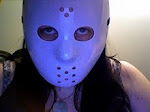
This plot is awesome. The whole book is awesome, but the plot just takes the cake. It reminds me more than a little of a modern
Charlie and the Chocolate Factory, with eccentric adults and a competition that's far more than it's advertised. But...well, just look at this plot.
Liam Digby is only twelve, but he's unusually tall and has premature facial hair--just a little of it, but enough to make him look stubbly. He doesn't love being called Wolverine or being treated like he's older than he really is just because he's tall (and stubbly), but the worst part is when his mother decides he needs to make friends. He points out that he has "loads of friends. I've got twenty guild members just waiting to do my bidding" (p. 27), but his mom means real life friends, not World of Warcraft.
So Liam's sent to Little Stars drama club, where he's stuck playing the giant alongside his classmate Florida. But a funny thing happens when they hang out at the mall after the meetings: people think Liam is an adult, and Florida is his daughter. Naturally Liam pushes this as far as a Porsche test drive; but when he's mistaken for his own father and wins a competition for great dads where he's one of four dads invited to a brand new adventure park in China--and since he has to show up with a "daughter," he convinces Florida to come with him.
And
that is just the beginning of the book.
Liam is smart, thoughtful, enthusiastic, and likable. He applies what he's learned in World of Warcraft to real life--with generally good results. He wants to travel and is frustrated that he lives in a town named Waterloo in Britain when he could live in the Waterloo in Sierra Leone or somewhere equally exotic. Of course he's going to head to China the first chance he gets.
What I love most about the book--and it's a hard choice, because this book is
freaking hilarious as well as entertaining--is how it quietly explores what it means to be a dad. It's charming and funny, and the plot zigzags from absurdity to absurdity without anything feeling stupid. My only complaint is the crappy Americanization of Mum to Mom and football to soccer--jarring, halfassed, and needless, since I don't think there's a kid in America who would be confused by the original terms. Other terms, like crisps instead of chips and biscuit instead of cookie, aren't changed.
Anyway, I loved this book so much I may reread it pretty soon just to make sure I caught all the jokes. I also know what book I'm giving my oldest nephew for his birthday this year. Incidentally, the science in this book is good too. It's all good.
B&N link









